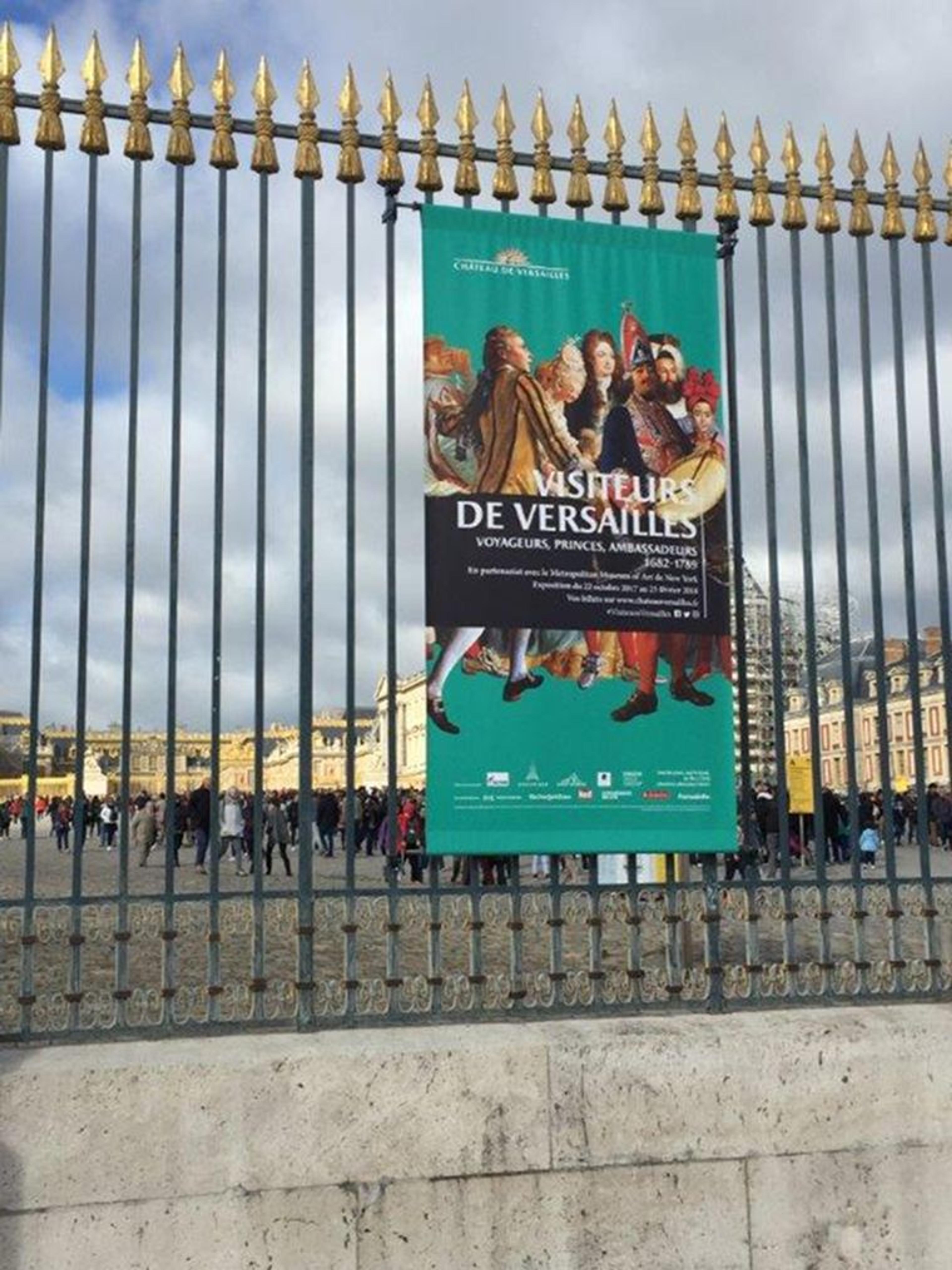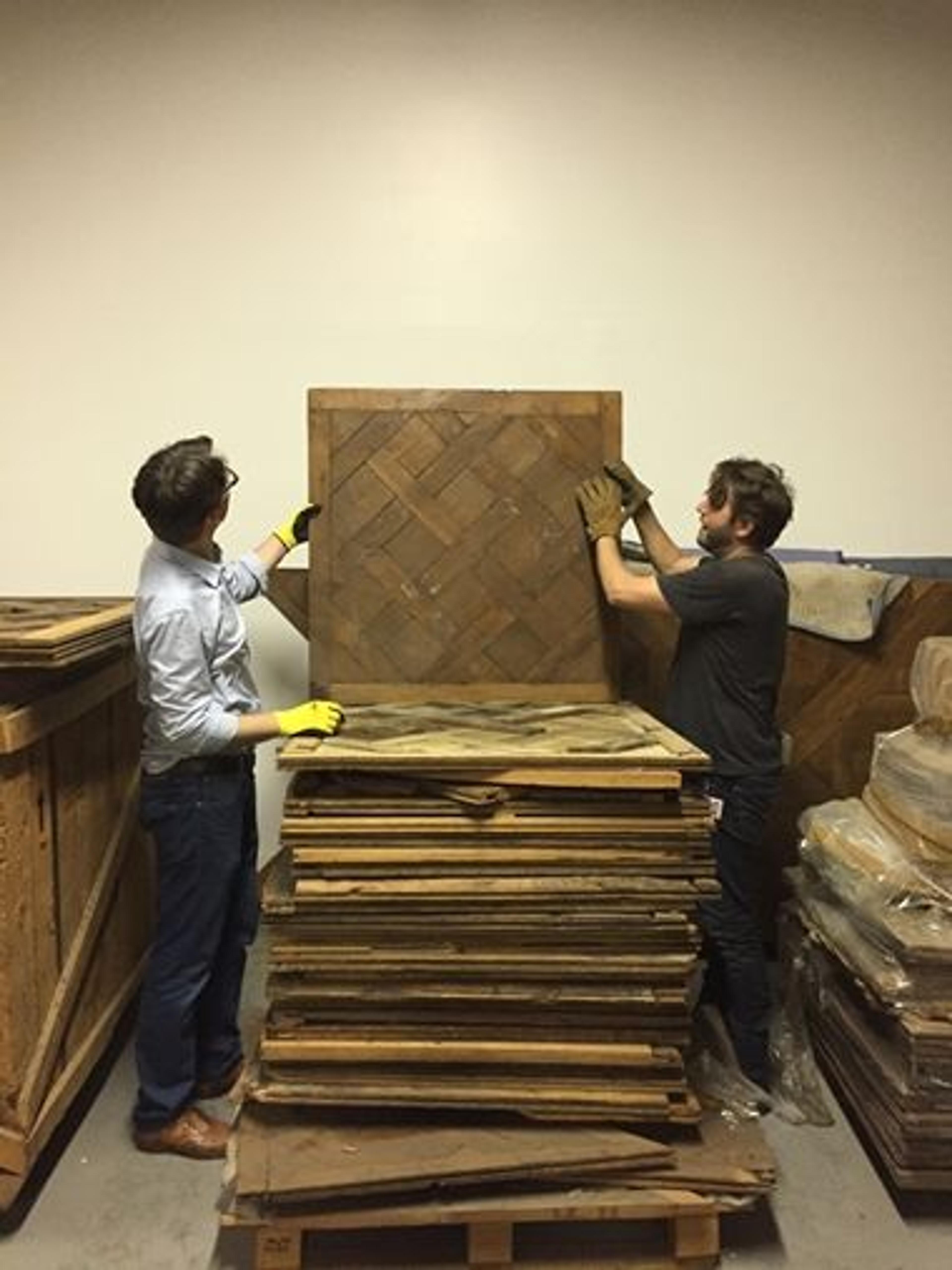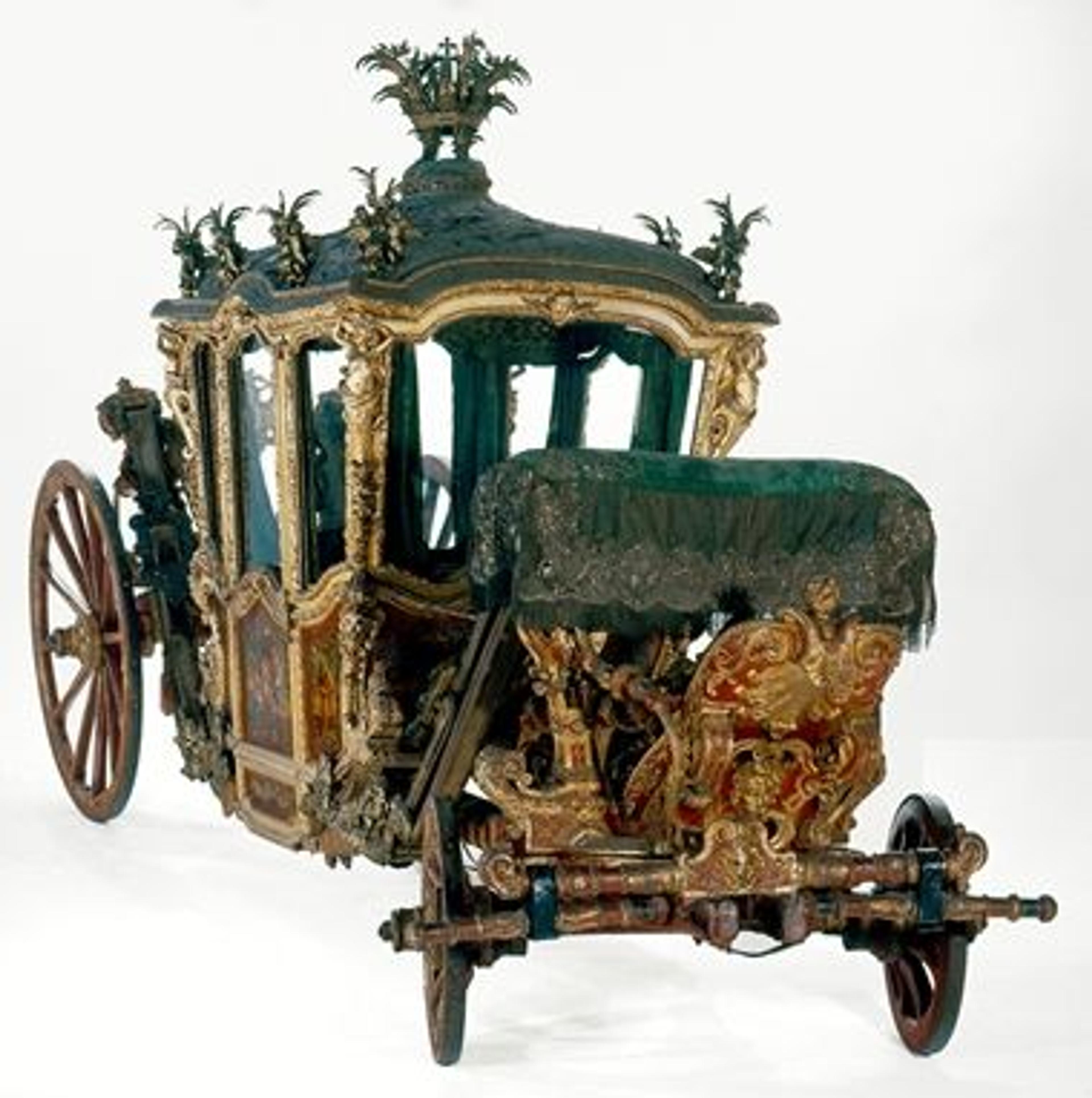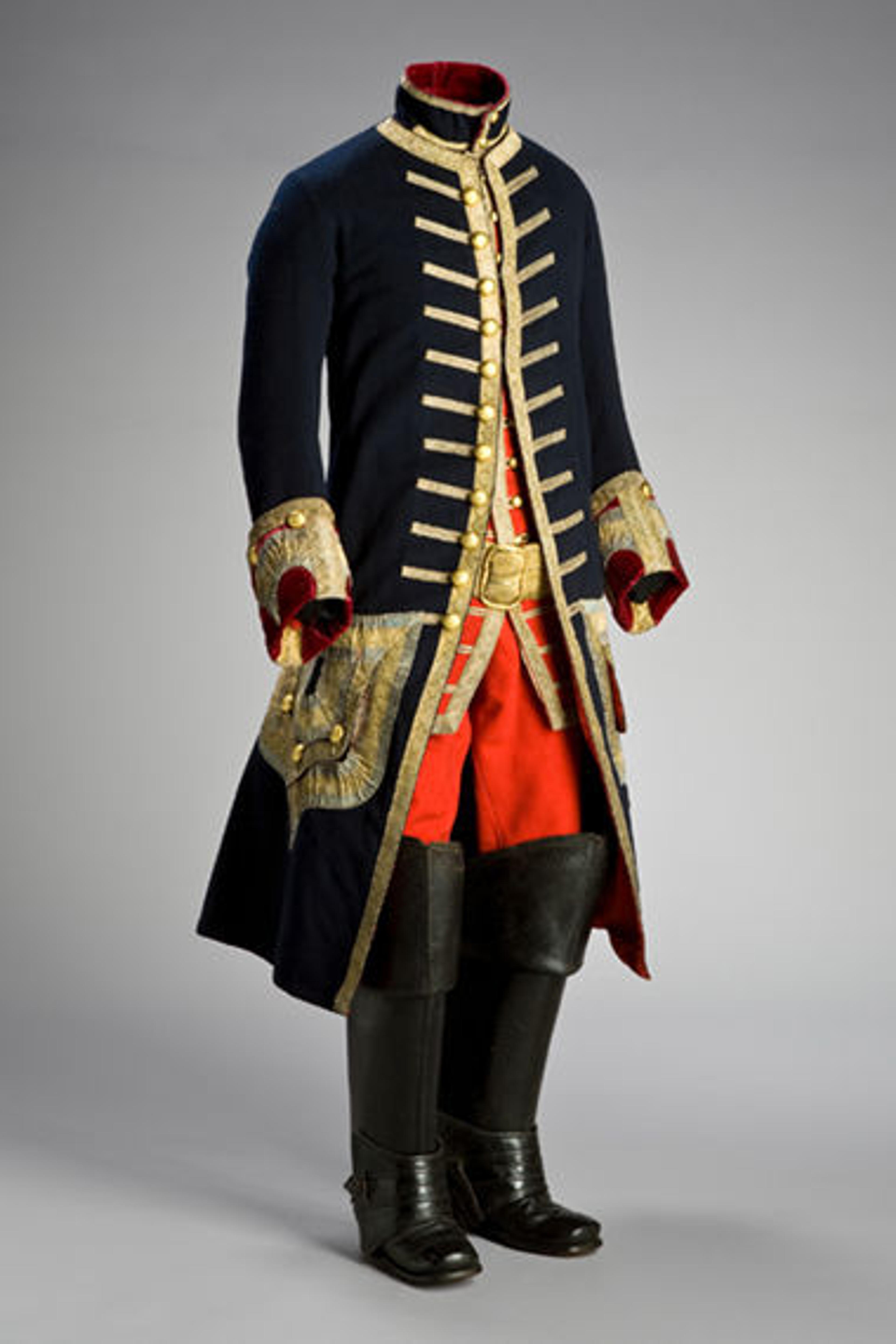Bringing Versailles to New York

View of Versailles in October 2017, with the banner for the show while on view at Versailles, its initial venue. Photo by the author
What was it like to visit Versailles when Louis XIV had transformed his father's royal hunting lodge into a magnificent Baroque palace? Answers to this question are found in a large number of late seventeenth- and eighteenth-century diaries, travel accounts, and correspondence. Most foreign travelers who visited Paris also made the excursion to Versailles to stroll in the formal gardens or wander through the Hall of Mirrors, hoping to catch a glimpse of the king. These descriptions were the genesis for Visitors to Versailles (1682–1789), an exhibition that takes a new look at the world-famous palace, seen for the first time from the travelers' perspective. The exhibition, on view at The Met Fifth Avenue from April 16 through July 29, 2018, is jointly organized by The Met and its first venue, the Palace of Versailles.
Initially, Bertrand Rondot, senior curator at Versailles and co-curator of the show, and I had planned to write a book about the travelers' narratives describing their visit to Versailles. This book project turned into an exhibition at the encouragement of Luke Syson, Iris and B. Gerald Cantor Chairman of the Department of European Sculpture and Decorative Arts at The Met. Clearly, a publication and an exhibition are two different things, and organizing a show requires much more than simply collecting stories—even though we found many! Guided by the accounts we selected themes, and subsequently artworks, to best convey the many aspects of a visit to Versailles.
Left: Conservator Marijn Manuels (left) in Objects Conservation and Juan Stacey (right), supervising departmental technician in the Department of European Sculpture and Decorative Arts, examine the parquet flooring in storage. Photo by the author

In planning this exhibition, one thing was obvious from the beginning: we would have to work a lot harder on the installation of the show at The Met than we would at Versailles to evoke the grandeur of Louis XIV's residence. How could we convey what it was like to visit the palace between 1682 and 1789, when it was the seat of the Bourbon Court?
To offer the visitor a long-perspective view that's characteristic of a Baroque palace, the exhibition design includes a series of galleries with their doorways aligned. This effect is further enhanced by the creative use of special wallpapers developed by The Met's talented design team—consisting of exhibition designer Alejandro Stein and graphic designer Ria Roberts, assisted by Patrick Herron, Frank Mondragon, and Tal Pritzker. For the furniture platforms, we decided to use eighteenth-century parquet flooring (in a pattern known as "parquet de Versailles"). Long buried in Museum storage, this wood flooring helps to create an authentic palace look. Readers can learn more about the exhibition design in an upcoming blog post by Stein and Roberts, part of a series accompanying the exhibition.

We were very fortunate to obtain almost all the loans we requested. The exhibition in New York includes nearly one hundred and ninety works from fifty-three different lenders in eleven countries on three continents, and from seven departments within The Met. We are especially pleased to display a suit that belonged to Benjamin Franklin, on loan from the Smithsonian's National Museum of American History. Made of plain, plum-colored silk (the lack of adornment certainly made the American diplomat stand out at the French court), the costume has to remain in low-light conditions in order to prevent it from fading.
Right: Three-piece suit (habit à la française), ca. 1778–79. French. Ribbed silk and linen (reproduction shirt, shoes, and stockings), 60 x 30 x 24 in. (152.4 x 76.2 x 61 cm). Smithsonian National Museum of American History, Washington, D.C. (2012.0187.001). Photo by Hugh Talman

Jans Fils and workshop. The Palace of Versailles and the Month of April, from the series The Royal Residences and the Months of the Year (detail), ca. 1673–77. French, Paris. Manufacture Nationale des Gobelins (French, established 1662). Wool, silk, metal thread, 13 ft. 1 1/2 in. x 21 ft. 3 7/8 in. (400 x 650 cm). Mobilier National, Paris (GMTT 108/4). Photo by the author
The requests for loans lead to several extensive conservation projects. To single out one example: a late seventeenth-century Gobelins tapestry with a view of Versailles underwent a yearlong treatment at the Mobilier National in Paris in order to close numerous old slits. In its newly conserved state, shimmering with gold and silver thread, this tapestry, originally on display in the State Apartments at Versailles, makes a great opening statement to the show.
One of the few disappointments was that the spectacular carriage commissioned in Paris by the Count of Ribeira Grande, Portuguese ambassador to the French court, for his official audience at Versailles in 1715, did not make the journey to New York. A military cargo plane would have been required to transport the imposing vehicle across the Atlantic, but we had to forego this loan when we discovered that the carriage would not fit through any of the Museum's doors!
Left:Carriage ordered in Paris by the Count of Ribeira Grande for his official audience at Versailles, 1715. Painted and gilded wood, metal, textiles, tortoiseshell, and brass, 7 ft. 10 in. x 12 f. 5/8 in. x 24 ft. 3/4 in. (240 x 370 x 740 cm.). Museu Nacional dos Coches, Lisbon (V 0007)

Early on, we considered different ways to express the travelers' experiences in the most compelling way. While the use of 360-degree photography or augmented reality might virtually "transport" our modern visitors to Versailles, we felt that these means would ultimately not do justice to the contemporary observations. For that reason, we decided to produce an immersive audio experience to showcase the first-person accounts of seventeenth- and eighteenth-century travelers, which is an integral part of the show. The result is these visitors can now "speak" for themselves. (For more on this, look for future posts by managing editor and producer Nina Diamond, who oversaw the making of the audio experience.)
Each of the galleries is devoted to a particular theme. Some are purely practical: How did one reach Versailles? The distance from Paris to the palace is about twelve miles. A trip by carriage took at least two hours, but frequently longer. How did one dress for court? Many European visitors transformed themselves by ordering new wigs and apparel in Paris according to the latest French fashion. In 1754, British architect Robert Adam wrote to his mother about the resulting change in his looks, asking: "Would you incline to know the appearance of your once plain friend? A most Frenchified head of hair, loaded with powder, ornaments his top; a complete suit of cut velvet of two colours, his body . . ."
Much to the surprise of many travelers, Versailles was one of the most public palaces in Europe, its state apartments accessible to anyone who was decently dressed. This openness reflected a long tradition of granting French subjects access to their ruler, and was a clear political calculation to present the magnificent palace as a symbol of the wealth and might of France and its monarch. It offered the visitor an opportunity to see the king during his highly structured schedule, especially his walk through the Hall of Mirrors on his way to attend the daily mass. Encountering Louis XIV on his return from the chapel, Dutch cloth merchant Pieter de la Court compared the king's figure in 1700 to that of a relative, "but with a bit more stomach."

Left: Pompeo Batoni (Italian, 1708–1787). John Montagu, Lord Brudenell, Later Marquess of Monthermer (detail), 1758. Oil on canvas, 38 x 28 in. (96.5 x 71.1 cm). Buccleuch Living Heritage Trust, The Duke of Buccleuch & Queensberry, Boughton House, United Kingdom (BLHT/BH/122). Photo by kind permission of the Duke of Buccleuch & Queensberry KBE. Right: Hester Lynch Piozzi (née Salusbury, later Mrs. Thrale), 1785–86. Oil on canvas, 28 x 3/4 x 24 3/4 in. (75.6 x 62.9 cm). The National Portrait Gallery, London (NPG 4942). © National Portrait Gallery, London
The various travel diaries describe the highlights of the palace (sometimes literally copied from published guidebooks). Some visitors, however, thought it redundant to write down their own observations: "The palace of Versailes [sic]," complained British tourist Philip Thicknesse in 1766, "has been so often described, that I find it as unnecessary, as it is difficult, to speak of such an amazing pile of building. . . ." His countrywoman Hester Thrale confessed in 1775 diary that the apartments at Versailles had "effaced every Sight my Eyes have yet seen for Riches, Pomp, & Beauty."
The formal gardens laid out by André Le Nôtre were another major attraction. Some visitors made multiple trips to see the waterworks play, as did the German architect Balthasar Neumann in 1723, who noted that, finally, "Yesterday I had the good fortune to see the fountains at Versailles operate for the first time." Most people made sure not to miss the labyrinth and the menagerie where the king's exotic animals were kept (both of which have since been destroyed).
Among the tourists were young noblemen from all over Europe on their Grand Tours, special trips undertaken to further their education, comparable to the semester abroad for today's college students. Lord John Brudenell Montagu visited the palace on December 30, 1751. The tutor Henry Lyte, who accompanied Brudenell on his travels, reported in a letter to Brudenell's father, George, 4th Earl of Cardigan, that the great gallery (the Hall of Mirrors) was splendidly illuminated and that they saw the king and queen at play.

Louis Michel Dumesnil (French, 1663–1739). The Formal Audience of Cornelis Hop at the Court of Louis XV, ca. 1720–29. Oil on canvas, 41 1/8 x 64 3/16 in. (104.5 x 163 cm). Rijksmuseum, Amsterdam, On loan from the Koninklijk Oudheidkundig Genootschap (SK-C-512)
Some travelers came to petition the king or look for royal patronage, as did the young Wolfgang Amadeus Mozart, who charmed the court with his music in 1763–64. Others came on official diplomatic missions since Versailles was also the seat of the French government. The ambassadorial reports from those visits tend to focus on the preparations for their official entry into Paris and on issues of protocol related to their public audiences with the king. The letters of ambassador Cornelis Hop to the Dutch States general, however, occasionally contain trivial if fascinating information about life at the court. For instance, he reported in January 1723 that Louis XV enjoyed himself by watching skaters on Versailles's Grand Canal.
The arrival of overseas embassies from as far away as Siam (in 1686), the Ottoman Empire (in 1721 and 1742), or Mysore (modern-day India, in 1788) were grand occasions celebrated with pomp and circumstance. The ambassadors, dressed in their native costume, carrying exotic gifts, was a sight to be seen. This, in and of itself, attracted many curious visitors to Versailles.

Left: Hunting costume, recorded 1771. French. Tailoring by Le Duc. Body: broadcloth with velvet details, gold and silver galloons; lining: wool (coat), silk (waistcoat), and chamois (breeches); swordbelt: chamois with gold galloons; boots: leather; body diameter: 34 1/4 in. (87 cm); length (coat, at the back): 42 1/2 in. (108 cm); length (waistcoat, at the back): 29 1/2 in. (75 cm); length (breeches): 23 5/8 in. (60 cm); swordbelt: 2 15/16 x 45 1/4 in. (7.5 x 115 cm); height (boots): 21 7/8 in. (55.5 cm). The Royal Armoury, Stockholm (11596–99, 27511–12). Photo by Matti Östling
Members of European royalty, such as the crown prince and future Gustav III of Sweden, often traveled incognito under an assumed name and lower title, making the journey less expensive and cumbersome. Splendid entertainments were organized for these private, high-ranking guests, including illuminations and fireworks, balls, and musical performances. In addition, they received precious gifts. The Swedish crown prince reported to his mother in 1771 that Louis XV had presented him with a hunting costume.
American presence played a significant role, especially after 1776, when France became the colonists' only military ally in their rebellion against Great Britain. Three of the Founding Fathers—Benjamin Franklin, John Adams, and Thomas Jefferson—visited Versailles to secure and maintain French support for the American cause. A popular figure at the court of Louis XVI, Franklin enjoyed the attention and became a celebrity in France, reporting to his daughter that the medallions with his likeness, along "with the pictures, busts, and prints . . . have made your father's face as well-known as that of the moon."

Cup and saucer (tasse litron), ca. 1779. French. Sèvres Manufactory (French, 1740–present), painted and gilded by Étienne-Henry Le Guay (French, active 1748–49, 1751–97). Soft-paste porcelain; cup: 3 x 4 x 3 in. (7.6 x 10.2 x 7.6 cm); saucer: 1 5/16 x 5 7/8 in. (3.3 x 14.9 cm). Hillwood Estate, Museum & Gardens, Washington, D.C., Bequest of Marjorie Merriweather Post, 1973 (24.151.1-2)
Criticism of the court's extravagant lifestyle, which was in stark contrast with the prevailing poverty among the French populace, grew stronger during the second half of the eighteenth century. The last, unwelcome visitors in our exhibition are the angry Parisians who marched to Versailles in October 1789 and forced the royal family to return to Paris. Never again would Versailles be the seat of the French court.
The palace and town abandoned, the number of tourists dwindled. Much of the royal furniture was sold in the Revolutionary sales of 1793–94. The exhibition closes with a reproduction of a poster advertising one of these auctions. Many palace furnishings left France at this time, and some of these important royal pieces were later acquired by The Met for its collection.
With nearly ten million tourists annually, Versailles is among the most visited historic sites in the world today. Celebrated in popular movies and television series, the royal residence continues to captivate a large audience. We hope that The Met's exhibition will allow our visitors to imagine what it was like to be at Versailles during the ancien régime.
Related Content
Visitors to Versailles (1682–1789) is on view at The Met Fifth Avenue through July 29, 2018.
Learn more about the binaural audio experience and view the exhibition galleries.
Read a blog series about Visitors to Versailles on Now at The Met.
The exhibition catalogue is available for purchase at The Met Store.
Daniëlle Kisluk-Grosheide
Daniëlle Kisluk-Grosheide is the Henry R. Kravis Curator in the Department of European Sculpture and Decorative Arts.